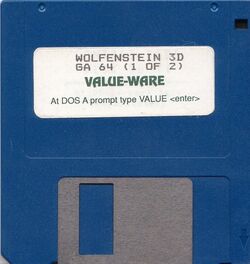| Floppy disk | |
|---|---|
 A 3.5" floppy disk | |
| Basic Information | |
Type(s) |
Storage Media |
| Awards | Covers | Credits | Gallery | Help Patches | Reviews | Screenshots | Videos | |
A Floppy disk is a magnetic data storage device that is composed of a circular piece of thin, flexible (i.e. "floppy") magnetic storage medium encased in a square or rectangular plastic wallet. Floppy disks are read and written by a floppy disk drive.
The image in the infobox is a 3.5" floppy, and can hold up to 1.44 megabytes of data. An older floppy disk format is the 5.25" floppy. The 3.5" floppy disk format was introduced by Sony in 1982, with its Sony SMC-70 computer. 3.5" floppy disks would become the standard storage medium for personal computers up until the late 1990s, when they would begin to be succeeded by ZIP disks and CD-ROMs.
Floppy disks are being phased out in the PC industry - companies like Apple and Dell have removed floppy disk drives from newer models of their computer systems. The format has been all but replaced by compact discs, which in turn are being made obsolete by the DVD.
History
- See also: Hard drive
Dr. Yoshiro Nakamatsu, in Tokyo, conceived the idea of a floppy disk in 1950. He later received a Japanese patent for inventing a floppy disk in 1952,[1] under the application number JP52011008,[2] and received an American patent dated 1958.[3] He later licensed 16 patents to IBM,[4] confirmed by IBM spokesmen Mac Jeffery[5] and Brian Doyle.[6] IBM reached licensing agreements with Nakamatsu in the late 1970s.[7][8]
The first commercial floppy disk was IBM's 8-inch floppy disk, introduced in 1972. In 1976, An Wang of Wang Laboratories invented a smaller 5¼-inch floppy disk, which became the standard floppy disk format from the late 1970s to the early 1980s.
The 3.5" floppy disk format was introduced by Sony in 1982, with its Sony SMC-70 computer. 3.5" floppy disks would become the standard storage medium for personal computers up until the 1990s.
References
- ↑ Lazarus, David (April 10, 1995). "'Japan's Edison' Is Country's Gadget King : Japanese Inventor Holds Record for Patent". The New York Times. https://www.nytimes.com/1995/04/10/news/10iht-matscon.ttt.html. Retrieved 2010-12-21.
- ↑ YOSHIRO NAKAMATSU – THE THOMAS EDISON OF JAPAN, Stellarix Consultancy Services, 2015
- ↑ Magnetic record sheet, Patent US3131937
- ↑ Twilight Zone: Dr. NakaMats inventions, Ping Mag, October 20, 2006
- ↑ Barron, James (Nov 11, 1990). "What a Stroke of ... Um, Ingenuity, Anyhow". The New York Times. https://www.nytimes.com/1990/11/29/nyregion/what-a-stroke-of-um-ingenuity-anyhow.html. Retrieved 2010-05-03.
- ↑ Spy, December 1991, page 49
- ↑ Lidz, Franz (December 2012). "Dr. NakaMats, the Man With 3300 Patents to His Name". Smithsonian Magazine. http://www.smithsonianmag.com/science-nature/dr-nakamats-the-man-with-3300-patents-to-his-name-134571403/?all. Retrieved October 15, 2014.
- ↑ Hornyak, Tim (January 2002). Dr. NakaMats: Japan's Self-Proclaimed Savior. Japan Inc. Retrieved on 2007-10-13
